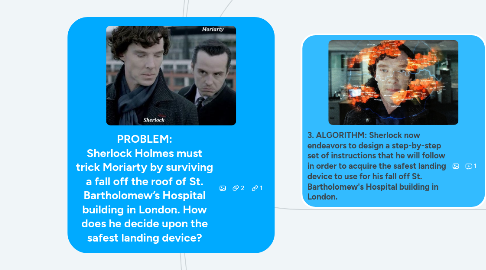PROBLEM: Sherlock Holmes must trick Moriarty by surviving a fall off the roof of St. Bartholomew’s Hospital building in London. How does he decide upon the safest landing device?
Door Lori Ruso


1. Pattern Rationale: Sherlock's search for patterns in the site-specific and landing device data exemplifies the computational thinking concept of pattern recognition because in order to achieve his intended goal of landing safely, he must not merely accept the data at face value, he must "begin to engage critically and purposefully with them [the data] instead." (Rushkoff, 2012, p. 3) To successfully survive his intended fall off of the building, it is imperative that Sherlock carefully analyze any corresponding data between the site-specific data & landing device data he's collected.
2. References: Rushkoff, D. (2012, November 13). Code literacy: A 21st century requirement. Edutopia. Retrieved from http://www.edutopia.org/blog/code-literacy-21st-century-requirement-douglas-rushkoff Wolfram, S. (2016 September 7). How to Teach Computational Thinking. Wired. Retrieved from https://www.wired.com/2016/09/how-to-teach-computational-thinking/ Yadav, Stephenson, Hong. (2017, April). Computational Thinking For Teacher Education. Communications of the ACM. Retrieved from https://cacm.acm.org/magazines/2017/4/215031-computational-thinking-for-teacher-education/fulltext?mobile=false Use of photos purchased from: Fanpop, Inc. © 2006-2019. All Rights Reserved. A Member of Townsquare Entertainment News. http://www.fanpop.com/clubs/sherlock-holmes-sherlock-bbc1/images/37200095/title/funny-sherlock-icon
3. 2. PATTERNS: As Sherlock reviews the site-specific data and landing device data he's collected, he must search for patterns, trends, and/or regularities in order to determine which landing device would function most safely at his specific fall site.
3.1. Pattern Recognition Task #1 Sherlock's site-specific data includes the following: St. Bartholomew Hospital building's height is approximately 50 feet. The surface type on the street in front of the building is asphalt concrete. Regarding the proximity of structures to the front of the building: There are two-12ft. sidewalks on either side of the street's 4 traffic lanes (48ft.), totaling 72ft. of space.
3.2. Pattern Recognition Task #2 Sherlock's landing device data includes the following: -Bunjee Chords: -recreational use over water -unsafe next to tall buildings -not used by fire & rescue depts. -Safety Nets: -used for 10ft falls or less -used with 10 or more handlers -no longer used by fire & rescue departments Inflatable Rescue Jump Cushions: -easy to inflate -safest method available -current go-to method used by fire & rescue depts.
3.3. Pattern Recognition Task #3 After carefully analyzing his collected data, Sherlock learns that the bunjee chord device would place his fall too close to the hospital building & most likely he'd be killed. He also learns that since his building is 50ft. tall, & safety nets fail to catch people falling from heights exceeding 1-story buildings, he would not survive the fall using a net. This leaves him to consider the inflatable rescue jump cushions: Historically, these devices have been successfully used for safely catching falling occupants from 50ft-tall buildings which works for his situation. When inflated, it would fit well within the 72ft. of available street space below him.
3.3.1. Safest ethod ailable

